The latest research taking place in the Teagasc Animal and Grassland Research Centre, Mellows Campus, Athenry, Co Galway, shows incorporating white clover into perennial ryegrass swards offers the potential to finish lambs up to 10 days quicker relative to perennial ryegrass-only swards.
The research, led by Philip Creighton, was undertaken from 2017 to 2021 and was presented at the recent Irish Grassland Association sheep conference.
The studies are a follow-on to previous research aimed at establishing the most efficient pasture-based lamb production system, where there was a particular focus on stocking rate (10, 12 and 14 ewes/ha) and medium and high levels of prolificacy.
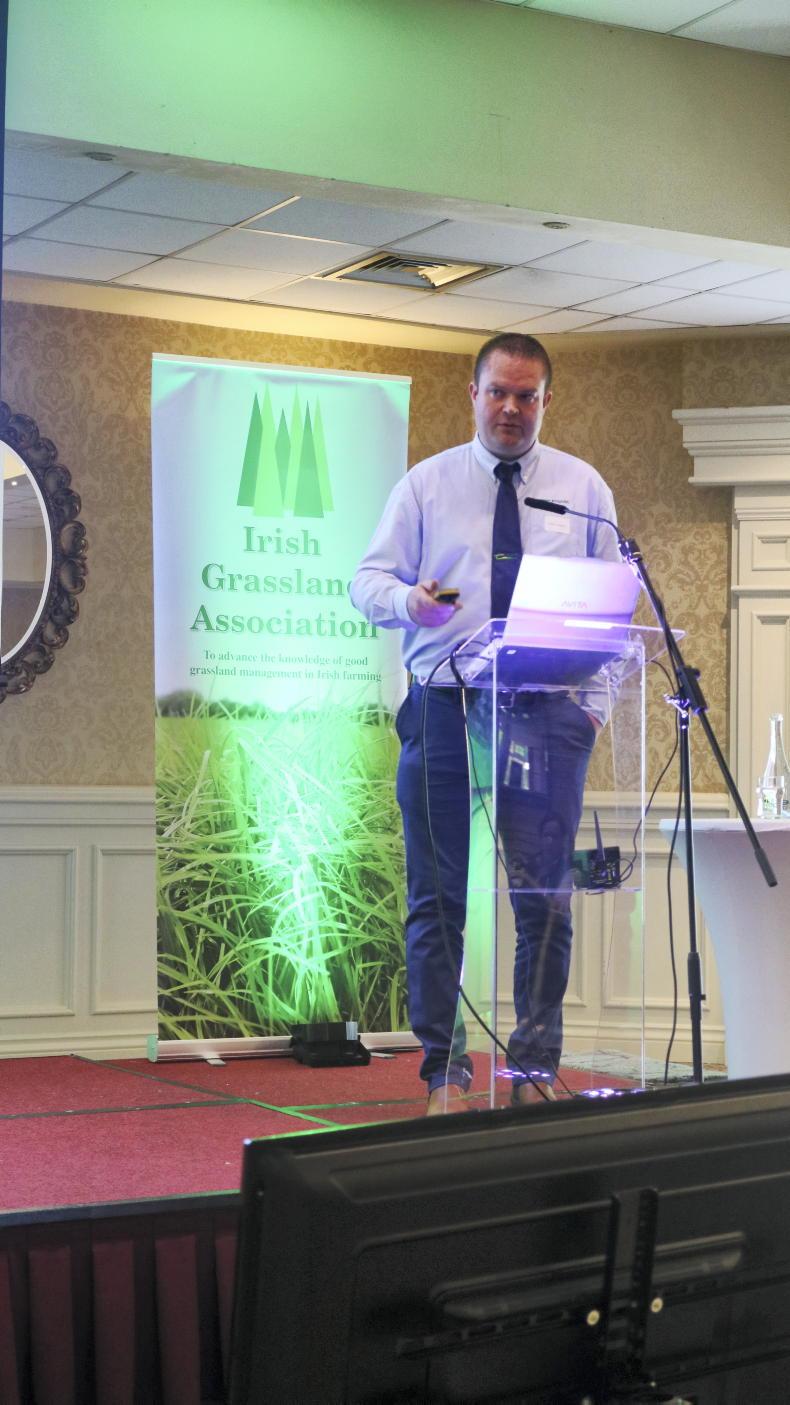
Philip Creighton, Teagasc.
According to Philip, the aim was to explore the effect of incorporating white clover on the productivity of pasture-based lamb production systems, with a special focus on the animal and associated environmental and economic impacts.
The latter area is especially timely, given the escalation in chemical fertiliser and concentrate costs.
Trial metrics
The experience of previous research showed the production system with a stocking rate of 14 ewes/ha put excessive pressure on the system.
Therefore, the stocking rate levels selected were 13 ewes/ha and 11 ewes/ha, with three pasture treatments as follows;
Grass-only sward receiving 145kg/ha chemical N annually (GO HN).Grass-white clover receiving 145kg/ha chemical N annually (GC HN).Grass-white clover receiving 90kg/ha chemical N annually (GC LN).Philip says: “Stocking rates are relatively high, but we are about pushing the system and if something fails, we will tell you it has failed. That’s our job, to test the limit of these things.”
The key findings in terms of lamb performance are detailed in Figure 1. This shows that the inclusion of white clover in the sward relative to perennial ryegrass-only swards resulted in lambs reaching slaughter weights up to 10 days faster. Philip explains that this is being driven primarily by higher lamb performance post-weaning.
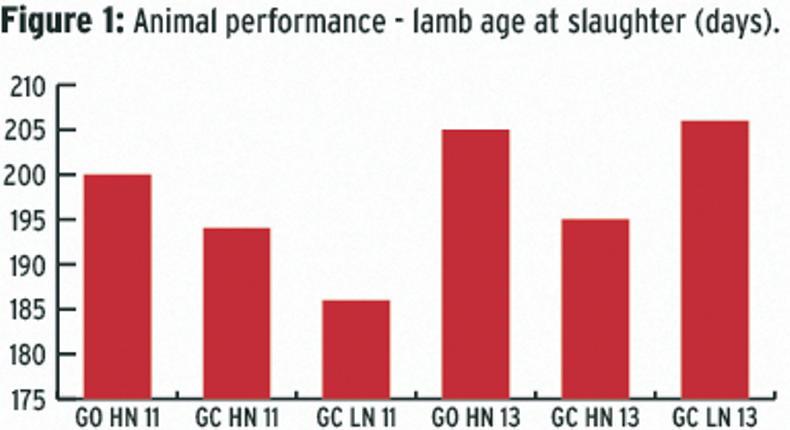
Higher daily liveweight gain
“In general, we are talking about a 10g to 15g/day improvement in lamb performance and mainly in the post-weaning period. It’s really this time of year, from May onwards, where clover kicks in to play, so that is where the main beneficial effects of it can be found.”
The greatest potential is in the lower stocking rate system. “Interestingly, our days to slaughter was lowest on our lowest nitrogen treatment sward, which developed a slightly higher clover content than our high nitrogen clover swards, but we wouldn’t be making huge claims about that.”
The situation at a stocking rate of 13 ewes/ha differed considerably, however.
“When we went to our higher stocking rate system, again pushing the boundaries a bit, we were able to get a reduction in days to slaughter on the swards that had the clover and were also receiving quite high levels of nitrogen.
“Where the wheels came off the bus a little bit in terms of output is where we went to the low nitrogen system at the high stocking rate. We just couldn’t sustain the demand from that system,” he said.
Previous experience
Philip outlines that a significant finding from their previous research highlighted that efficient production requires 1t grass dry matter per ewe per hectare. As detailed in Figure 2, the grass clover low nitrogen treatment stocked at 13 ewes/ha only produced 12.5t of grass.
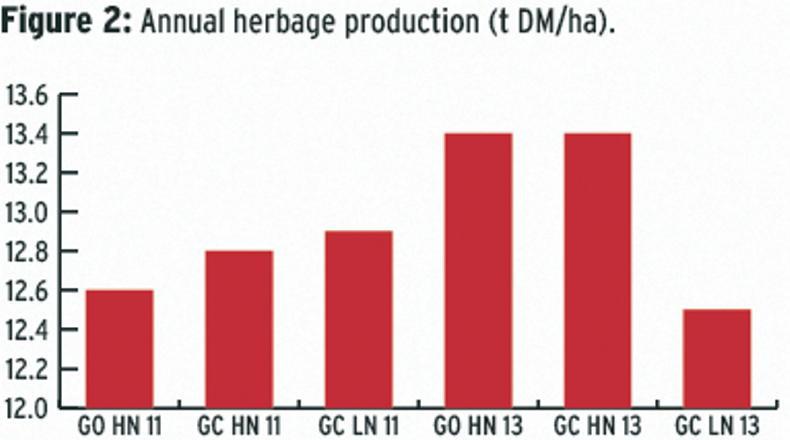
“We were under pressure for feed in that system right through summer and into August. The lamb growth rates would have been lower because we weren’t able to build that autumn cover going in to September, October and November to sustain grass demand from the ewes and lambs. We ended up having to supplement lambs with extra concentrates in those high stocking rate groups.”
“The message there is that we were able absolutely to make use of clover to a point, but when we go to those high stocking rate systems, and we would have said this message in the past, there is a limit to everything.”
Future studies
Philip says they have seen that a positive increase in lamb performance and herbage production can be obtained from relatively low levels of clover.
Increasing the percentage of clover in swards is difficult in sheep production systems, due to the dense nature of swards, with dairy swards in contrast capable of achieving 20% clover content in swards with greater ease.
As such, more research is taking place to explore if grazing systems can be manipulated to achieve even greater gains.
“Is it the way that we are sowing it, is it the way that we are grazing it, is it the way that is being put in, in terms of the amount of seed or the companion grasses present? There are issues there around application timings (fertiliser) and we need to see if we can refine this.”
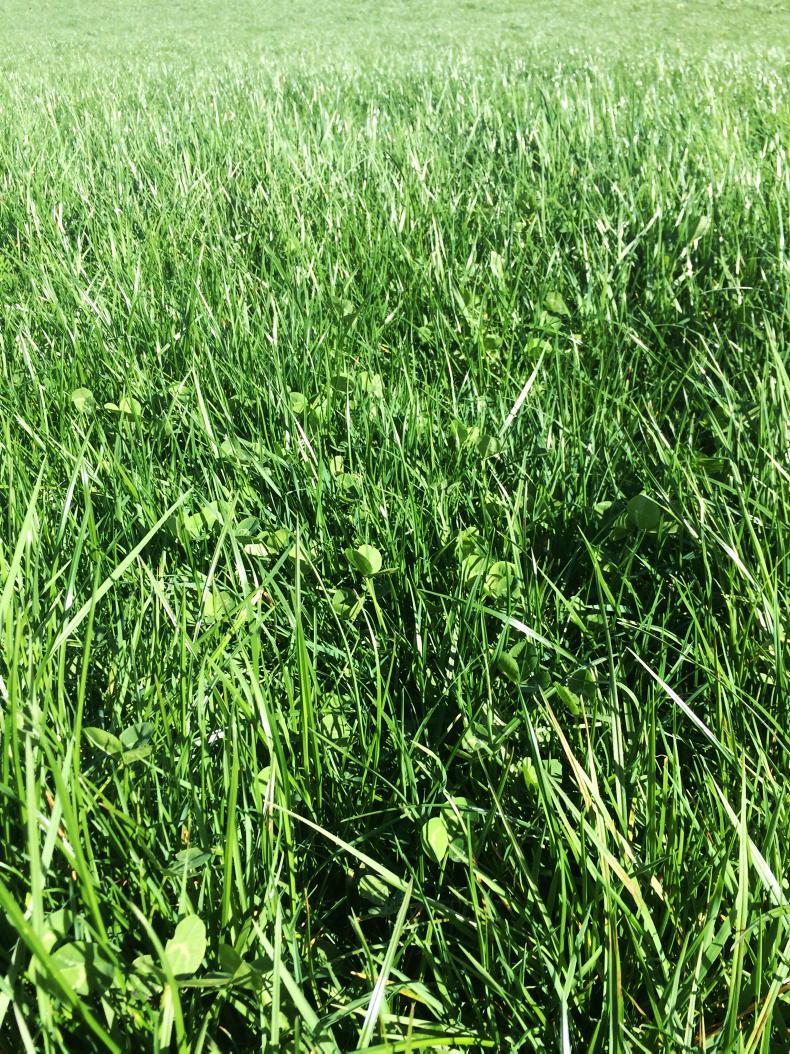
Clover and perennial ryegrass swards in Mellows Campus, Athenry, Co Galway.
This work is part of the PhD studies of Teagasc Walsh Scholars Lisa McGrane and Sarah Woodmartin, in collaboration with UCD, which is also looking at the role that other companion forages such as red clover, chicory and plantain could have on animal intake, performance and output.
Further information on this study will be presented at the Teagasc sheep open day taking place in Mellows Campus on 18 June.
Methane benefits
Philip touched briefly on work being carried out as part of Sarah Woodmartin’s PhD, looking at methane production across the different grazing treatments.
The grass-clover swards are achieving a reduction in methane output in animals ranging anywhere from 15% to 20%, looking at it in terms of total production or methane produced per kilogram of dry matter intake.
The findings are based on one year’s worth of data and as such, it was highlighted that further research is required before these initial positive outcomes can be confirmed.
Financial benefits
The financial performance across the systems is presented in Figure 3. The net margin attainable across the three high stocking rate systems is based on the years 2018 to 2021, similarly with high levels of lamb output, supported by high levels of nitrogen use (and concentrate use for the grass-clover low nitrogen treatment) underpinning financial performance.
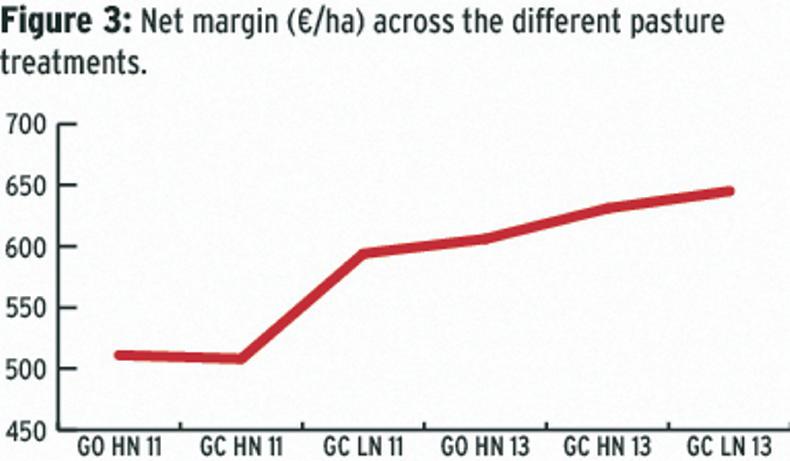
Philip outlines that were the effects of an escalation in nitrogen and concentrate prices factored into the system, then the economics of the grass-clover low nitrogen systems would increase, with nitrogen costs in the system increasing by 127% in 2022.
Further economic modelling will be carried out to determine the effect that rising fertiliser and concentrate costs have on such systems of production. A simple calculation was presented showing that the difference between the high and low nitrogen systems is 55kg nitrogen.
This was costing €47 at a price of €380/t for protected urea and jumps to €148 at a price of €1,200/t.
Taking clover seed at €10 per kg and oversown at 7.5kg/ha, with a cost of oversowing at €100/ha, total costs are in the region of €175/ha, €43/ha over four years or €58/ha over three years, showing that there is now a major financial saving in incorporating clover into your farm system.
The latest research taking place in the Teagasc Animal and Grassland Research Centre, Mellows Campus, Athenry, Co Galway, shows incorporating white clover into perennial ryegrass swards offers the potential to finish lambs up to 10 days quicker relative to perennial ryegrass-only swards.
The research, led by Philip Creighton, was undertaken from 2017 to 2021 and was presented at the recent Irish Grassland Association sheep conference.
The studies are a follow-on to previous research aimed at establishing the most efficient pasture-based lamb production system, where there was a particular focus on stocking rate (10, 12 and 14 ewes/ha) and medium and high levels of prolificacy.

Philip Creighton, Teagasc.
According to Philip, the aim was to explore the effect of incorporating white clover on the productivity of pasture-based lamb production systems, with a special focus on the animal and associated environmental and economic impacts.
The latter area is especially timely, given the escalation in chemical fertiliser and concentrate costs.
Trial metrics
The experience of previous research showed the production system with a stocking rate of 14 ewes/ha put excessive pressure on the system.
Therefore, the stocking rate levels selected were 13 ewes/ha and 11 ewes/ha, with three pasture treatments as follows;
Grass-only sward receiving 145kg/ha chemical N annually (GO HN).Grass-white clover receiving 145kg/ha chemical N annually (GC HN).Grass-white clover receiving 90kg/ha chemical N annually (GC LN).Philip says: “Stocking rates are relatively high, but we are about pushing the system and if something fails, we will tell you it has failed. That’s our job, to test the limit of these things.”
The key findings in terms of lamb performance are detailed in Figure 1. This shows that the inclusion of white clover in the sward relative to perennial ryegrass-only swards resulted in lambs reaching slaughter weights up to 10 days faster. Philip explains that this is being driven primarily by higher lamb performance post-weaning.

Higher daily liveweight gain
“In general, we are talking about a 10g to 15g/day improvement in lamb performance and mainly in the post-weaning period. It’s really this time of year, from May onwards, where clover kicks in to play, so that is where the main beneficial effects of it can be found.”
The greatest potential is in the lower stocking rate system. “Interestingly, our days to slaughter was lowest on our lowest nitrogen treatment sward, which developed a slightly higher clover content than our high nitrogen clover swards, but we wouldn’t be making huge claims about that.”
The situation at a stocking rate of 13 ewes/ha differed considerably, however.
“When we went to our higher stocking rate system, again pushing the boundaries a bit, we were able to get a reduction in days to slaughter on the swards that had the clover and were also receiving quite high levels of nitrogen.
“Where the wheels came off the bus a little bit in terms of output is where we went to the low nitrogen system at the high stocking rate. We just couldn’t sustain the demand from that system,” he said.
Previous experience
Philip outlines that a significant finding from their previous research highlighted that efficient production requires 1t grass dry matter per ewe per hectare. As detailed in Figure 2, the grass clover low nitrogen treatment stocked at 13 ewes/ha only produced 12.5t of grass.

“We were under pressure for feed in that system right through summer and into August. The lamb growth rates would have been lower because we weren’t able to build that autumn cover going in to September, October and November to sustain grass demand from the ewes and lambs. We ended up having to supplement lambs with extra concentrates in those high stocking rate groups.”
“The message there is that we were able absolutely to make use of clover to a point, but when we go to those high stocking rate systems, and we would have said this message in the past, there is a limit to everything.”
Future studies
Philip says they have seen that a positive increase in lamb performance and herbage production can be obtained from relatively low levels of clover.
Increasing the percentage of clover in swards is difficult in sheep production systems, due to the dense nature of swards, with dairy swards in contrast capable of achieving 20% clover content in swards with greater ease.
As such, more research is taking place to explore if grazing systems can be manipulated to achieve even greater gains.
“Is it the way that we are sowing it, is it the way that we are grazing it, is it the way that is being put in, in terms of the amount of seed or the companion grasses present? There are issues there around application timings (fertiliser) and we need to see if we can refine this.”

Clover and perennial ryegrass swards in Mellows Campus, Athenry, Co Galway.
This work is part of the PhD studies of Teagasc Walsh Scholars Lisa McGrane and Sarah Woodmartin, in collaboration with UCD, which is also looking at the role that other companion forages such as red clover, chicory and plantain could have on animal intake, performance and output.
Further information on this study will be presented at the Teagasc sheep open day taking place in Mellows Campus on 18 June.
Methane benefits
Philip touched briefly on work being carried out as part of Sarah Woodmartin’s PhD, looking at methane production across the different grazing treatments.
The grass-clover swards are achieving a reduction in methane output in animals ranging anywhere from 15% to 20%, looking at it in terms of total production or methane produced per kilogram of dry matter intake.
The findings are based on one year’s worth of data and as such, it was highlighted that further research is required before these initial positive outcomes can be confirmed.
Financial benefits
The financial performance across the systems is presented in Figure 3. The net margin attainable across the three high stocking rate systems is based on the years 2018 to 2021, similarly with high levels of lamb output, supported by high levels of nitrogen use (and concentrate use for the grass-clover low nitrogen treatment) underpinning financial performance.

Philip outlines that were the effects of an escalation in nitrogen and concentrate prices factored into the system, then the economics of the grass-clover low nitrogen systems would increase, with nitrogen costs in the system increasing by 127% in 2022.
Further economic modelling will be carried out to determine the effect that rising fertiliser and concentrate costs have on such systems of production. A simple calculation was presented showing that the difference between the high and low nitrogen systems is 55kg nitrogen.
This was costing €47 at a price of €380/t for protected urea and jumps to €148 at a price of €1,200/t.
Taking clover seed at €10 per kg and oversown at 7.5kg/ha, with a cost of oversowing at €100/ha, total costs are in the region of €175/ha, €43/ha over four years or €58/ha over three years, showing that there is now a major financial saving in incorporating clover into your farm system.











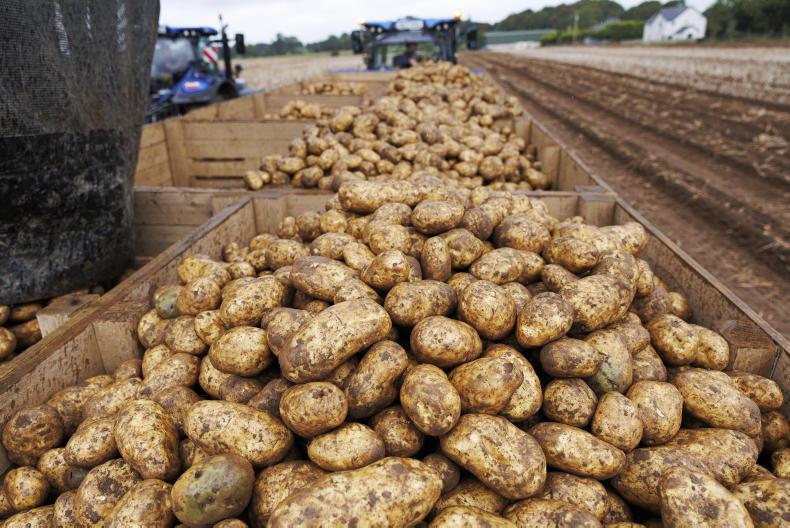
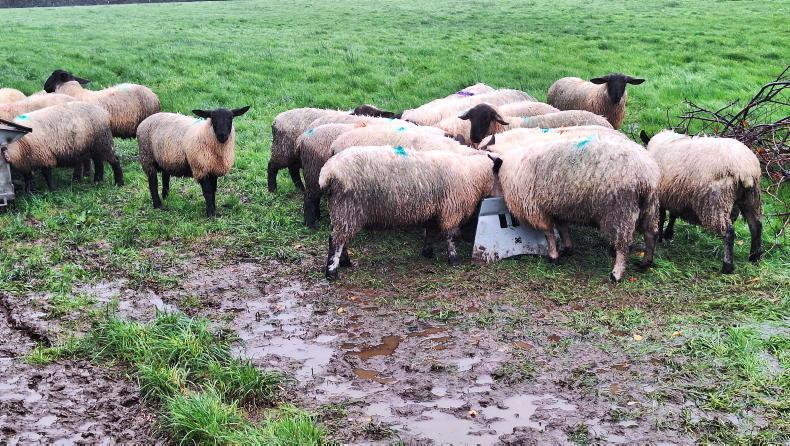
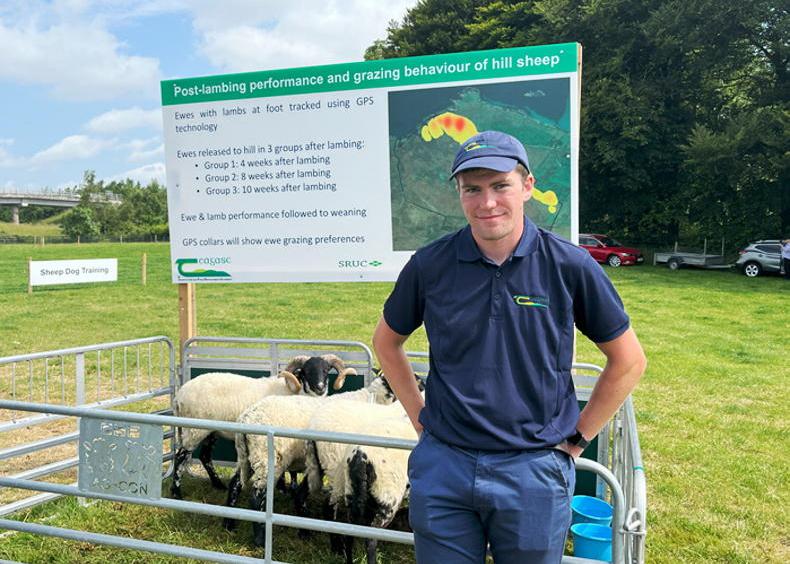
SHARING OPTIONS